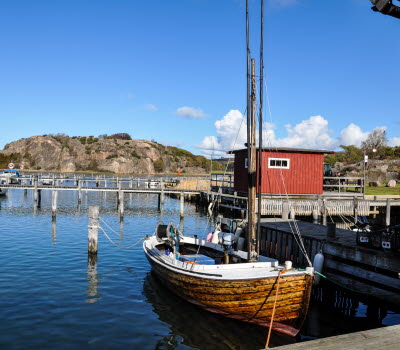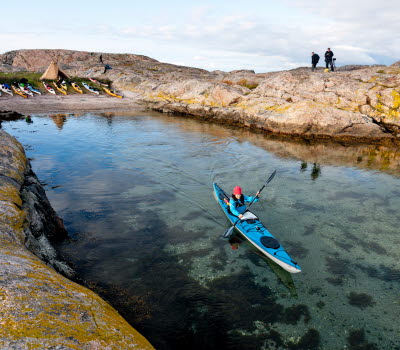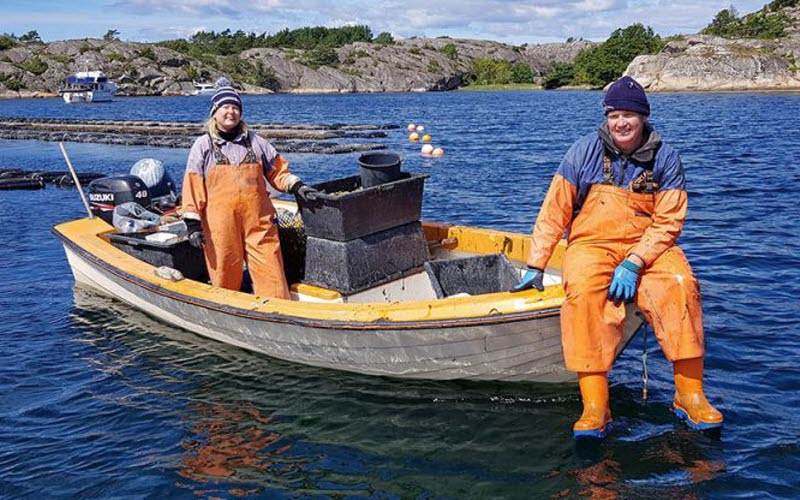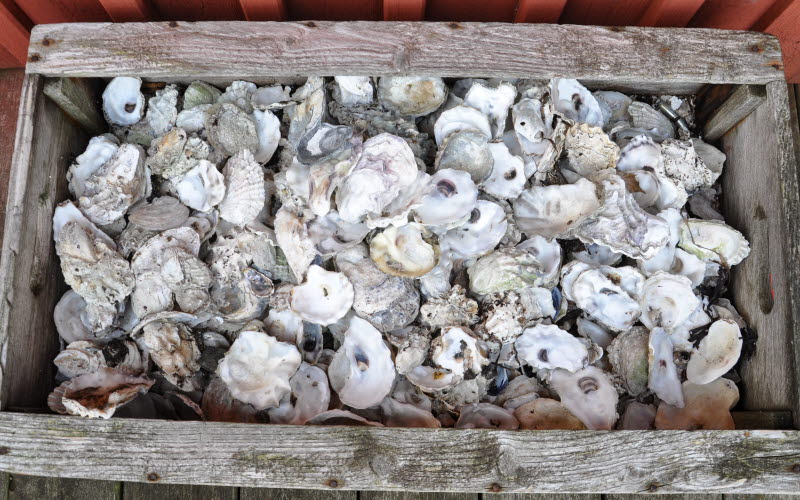A Mecca for Oyster Enthusiasts!
90% of Sweden's oysters come from Grebbestad and its surroundings and are considered by connoisseurs to be of the utmost world-class quality, if not the best! Throughout the Tanum municipality, you can experience both fishing for and eating these delicacies - in their rightful environment.
- The Best Conditions Yield the Best Oysters.
Photographer: Madeleine Landley
The conditions in the water in our archipelago, with its low temperature, clean water, and salinity, favor the oysters. And these conditions were crucial for the survival of the oyster Ostrea edulis when parasites devastated the species in many parts of Europe during the 1960s. In Kosterhavets National Park, fresh, oxygen-rich Atlantic water is pumped in, providing excellent conditions for shellfish overall but especially ideal for oysters.
In Tanum, there are ample opportunities to both fish for and taste various oysters. Here, a wide range of experiences related to oysters is offered, including harvesting, oyster schools, and oyster tastings.
-"Oysters are like life, like the salt of tears, like the body itself. The taste shoots into the bloodstream, numbing our senses." - Inger Grimlund, editor, food writer.
The European Oyster "Ostrea Edulis"
Our "own oyster," the European oyster, Ostrea Edulis, also known as Belon, occurs from the Mediterranean in the south to Norway in the north. It is considered by connoisseurs to be of the utmost world-class quality, if not the best, with a delightful chewiness. Along the Swedish west coast, oysters are found down to Varberg, where the low salinity in the water limits their distribution. The densest oyster beds are found at depths of 3-8 meters on the southwest side of islands with relatively sandy, gently sloping bottoms.
The oyster is 7-15 cm in diameter and has a rough and gray exterior. On the inside, it shimmers with mother-of-pearl, and the oyster meat smells of the sea and has a taste of saltwater, minerals, seaweed, and umami.
"It's like tending a garden," say the oyster divers who notice a significant difference between a well-maintained and an unused oyster bed. Oyster beds are owned by the water owner up to 200 meters into the sea, and therefore, permission must be obtained from them to pick oysters.
Pacific Oyster "Magallana Gigas"
In the Kosterhavet area, for about 15 years, the Pacific oyster, "Magallana Gigas" - the Pacific oyster, has also been living, having arrived with currents from Danish waters. The Japanese giant oyster is the most cultivated oyster in the world. It originates from the Pacific Ocean and is today the most common oyster in European waters after being introduced to France in the 1970s.
Oyster Farmers and Growers in Our Municipality
Kalvö Oysters are Ostrea edulis that live freely off the coast of Fjällbacka and are handpicked by divers or caught by fishermen equipped with nets, water binoculars, and waders.
Photographer: Celina Falck
Here, oysters have been harvested by "oyster farmers" since the 17th century. With incredible knowledge and reverence for the oyster beds, Kalvö Oysters operates its family business, offering you the opportunity to pick oysters yourself, attend oyster schools, and participate in oyster tastings.
Åsa Hardin, Kalvö Levande Skärgård AB
The Pacific Oyster "Magallana Gigas," also known as the Pacific oyster, is also found in the waters around Kalvö, and at Kalvö Oysters, you have the opportunity to try both and evaluate the flavors.
Grebbestad Oysters
Grebbestad Oysters are the brand for the European oyster Ostrea edulis, which lives freely in the northern and southern archipelagos of Grebbestad. The oysters should either have been handpicked by divers or caught by fishermen equipped with nets, water binoculars, and waders. Since May 2023, these oysters have also been protected by EU origin protection, which of course reinforces Grebbestad as the "Oyster Capital."
Klemming brothers - Bengt & Peter
Today, the area for Grebbestad oysters constitutes a significant portion of the remaining population of the wild European oyster. Naturally desirable, but our oysters are also important for our seas and to ensure the survival of the species, fishing for Grebbestad oysters is limited to 50,000-60,000 per year. The fishing is mainly carried out by Bröderna Klemmings Dykhjälp & Klemmings Ostron, who carefully dive and handpick the oysters without disturbing the seabed where the oysters live.
Join Bröderna Klemmings Dyk for oyster safaris, diving excursions, and courses.
Photographer: TanumStrand
Cultivated Oysters
Havstenssunds Ostron is currently the only commercial oyster farm in Scandinavia. Every week throughout the season, which runs from September to May, we sort and harvest consumption-sized oysters that we deliver to wholesalers, fishmongers, and directly to restaurants. For several years now, we have also been harvesting oysters from the wild population, both the native flat oysters (Ostrea edulis) and the invasive Pacific oysters (Magallana Gigas).
Havstenssunds Ostron also hosts events at their venue, Södra Magasinet, in Havstenssund harbor, and offers tours of their farm. The oysters are highly appreciated and used in oyster opening competitions such as the Nordic Championships in Grebbestad.
The Oyster Academy
What solidifies the capital of Oysters is the presence of its own academy in Grebbestad. The Oyster Academy, a non-profit organization formed in 2004, works to increase knowledge and interest in the Swedish oyster Ostrea edulis. The association collaborates with fishermen, researchers, landowners, restaurateurs, and the tourism industry. The Oyster Academy is open to all interested parties, and membership is indeed a must for all oyster lovers.
In 2005, the Oyster Academy was awarded the honorary mention "Årets Skarpsill" (Herring of the Year) by the industry organization Svensk Fisk (Swedish Fish). The academy hosts the Nordic Championships in Oyster Opening every year in May and Oyster Day in September, both in Grebbestad.
Small Oyster School
Oyster Harvest Season
Oysters are harvested from the first week of September until midsummer, when the oysters undergo their reproductive period during July-August, and it's important to let the oysters be.
Ostrea Edulis is harvested when they are at least 3-4 years old, while Crassostrea Gigas has a much faster growth phase and is harvested when they are around 1 year old.
Oysters are hermaphroditic, meaning the same individual can reproduce as both male and female. When an oyster reaches sexual maturity, at about one year of age, it reproduces as a male. At three years of age, if the water temperature permits, they can reproduce as females, and then as males again. After that, they alternate between male and female for the rest of their lives. They feed on phytoplankton and thus occupy a secondary position in the food chain.
Therefore, they are very beneficial, rich in trace elements, minerals, vitamins, and are the most vitamin B12-rich food known, which is good for, among other things, blood formation. The oyster also contains the important antioxidant selenium, so this delicacy from the sea is truly a healthy and nutritious food. In winter, glycogen is formed in the oyster, which gives it a certain sweetness.
In the past, oysters were fished with dredges, rakes, and special tongs, but now only by divers. Both Grebbestad oysters and Kalvö oysters are only hand-fished by divers or with water binoculars. They are wild-caught, and the craftsmanship around the oyster beds is important for the survival of the oysters, which in turn are important for our oceans with their cleansing effect.
"The Right Oyster" - How to Know You've Got the "Right Oyster"
There are two sizes of oysters: 1s and 2s. The 2s are smaller and must have a minimum size of 6 cm. Our oyster is round and flat, unlike the imported, often French ones, which originally come from Japan and are elongated and convex.
Storage
Only store the oyster with the convex side down! This keeps the oyster water in the deep half-shell. Otherwise, the water will drain out, it will become dry, and it will die faster. Of course, in an unbroken cold chain! The shells should close when you tap on them, and always remember to smell them - they should smell fresh and of the sea.
Oyster Cooking
Oysters can, of course, be prepared in a variety of ways, such as gratins, soups, etc., but many prefer to eat our own, Bohuslän-style oysters raw due to their excellent quality and taste.
If you want to enjoy something delicious with them, a dry white wine, such as Chablis/Muscat, pairs well. Another option is our Swedish Carnegie Porter, which complements them nicely, but the Oyster Academy's own Champagne is the ultimate choice. In collaboration with ChampagneHuset, the Oyster Academy has selected a Grand Cru Champagne from Le Mesnil s/Oger in the heart of Cote de Blancs in Champagne.
Photographer: Lars Ardarve
Oyster Opening Competitions
There are competitions in oyster opening, Swedish Championships, Nordic Championships, European Championships, World Championships, etc., where 30 oysters are opened neatly and quickly. In about 2 minutes and 30 seconds, you can win the World Championship!
Photographer: Sonja
The name oyster comes from the Greek word "Ostrace," which loosely translates to ballot. This is because oyster shells were used as ballots in the dawn of democracy.
Source: Ostronakademien, Klemmings Ostron, Kalvö Ostron, Havstenssunds Oysters, Klemmings Dyk













